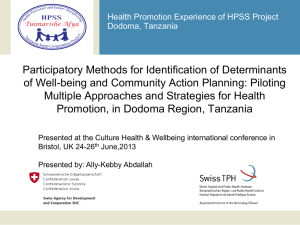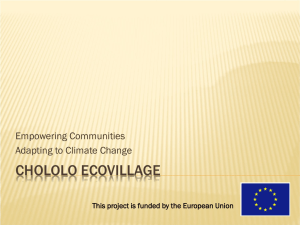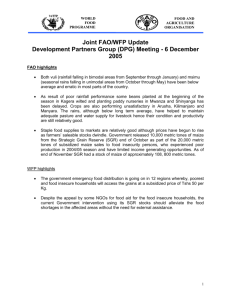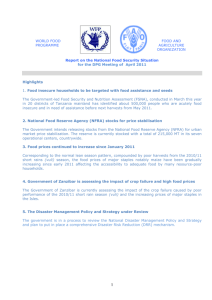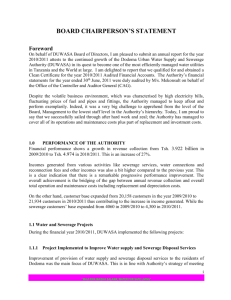ESA_Legg - Africa RISING
advertisement
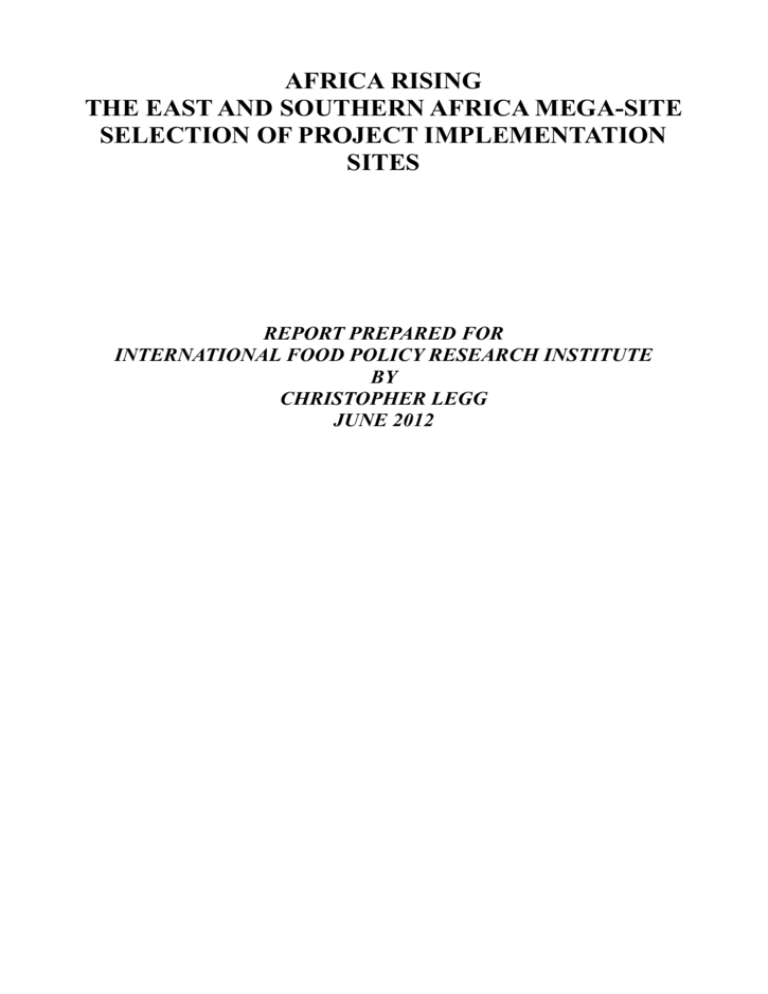
AFRICA RISING THE EAST AND SOUTHERN AFRICA MEGA-SITE SELECTION OF PROJECT IMPLEMENTATION SITES REPORT PREPARED FOR INTERNATIONAL FOOD POLICY RESEARCH INSTITUTE BY CHRISTOPHER LEGG JUNE 2012 Introduction The Africa RISING project of the Feed the Future Initiative proposes to initiate and test interventions to enable sustainable intensification of agriculture in three major regions of Africa by working in “mega-sites” which exemplify the main climatic and human characteristics of these regions. The Dodoma and Manyara regions of Tanzania have been chosen to represent the East and Southern Africa mega-site, and results of the initial project will be capable of extrapolation to wide areas of east and southern Africa, as shown in Figures 1 and 2. This report analyses and stratifies the Tanzania mega-site, and present recommendations for selection of operational sites within the mega-site. Figure 1. Extrapolation zones for Africa RISING mega-sites Figure 2. Extrapolation zones from East/Southern Africa Mega-Site Background to the Mega-Site According to the Concept Note for East and Southern Africa, “Feed the Future (FtF) Tanzania is focusing on reducing poverty and improving nutrition through key investments to improve availability and access to staple foods by enhancing the competitiveness of smallholders. These investments are being geographically focused in areas with high agricultural potential bordering chronically food insecure districts: Morogoro (rice); Manyara and Dodoma (maize); and Arusha, Kilimanjaro, Tanga, Zanzibar, Dar es Salaam, Morogoro, Iringa and Mbeya (horticulture). Dodoma and Manyara Regions in Tanzania are the geographic focus for this project. These areas are located in the Southern Agriculture Growth Corridor of Tanzania. Dodoma Region is a region centrally positioned in Tanzania. This Region is bordered by Manyara Region in the North, Morogoro in the East, Iringa in the South and Singida in the West. Much of the region is a plateau rising gradually from some 830 metres. There are three agro-ecological sub-zones in this region. Zone I includes the drier areas with 300-500 mm. This agro-ecological zone covers most of the Manyara region and the Masai Steppe in Northeast part of Kondoa, Southern part of Dodoma Rural and Southwest part of Mpwapwa District. The area is dominated by dry, flat or undulating plain with low population. Rainfall is very unreliable. The soils are mostly reddish-brown loamy sands with grey clays in depressions. Major crops in these areas are sorghum, pearl millet, cassava, sweet potatoes, groundnuts, simsim, grapes, Lablab purpureus and sunflower. Potential legume crops include pigeon pea, and cowpea. Potential vegetable crops include African eggplant, Ethiopian mustard, African nightshade, amaranth and vegetable cowpea Zone II has rainfall of 500-700 mm. It covers central and southern part of Kondoa District, Northern part of Dodoma District, the whole part of Kongwa District and part of Mpwapwa. The area has dark-brown and dark-reddish loamy sands. Major crops are maize, sorghum, groundnuts, grapes, sunflower, cassava, and simsim. Cowpea, tepary (Phaseolus actufilius) and pigeon-pea are legumes with high potential. Ethiopian mustard, African nightshade and vegetable cowpea are vegetables with high potential. Zone III has better rainfall of 700mm-1000mm. It covers the central part of Mpwapwa District and the Bereko highlands in Kondoa District. This area has deep dark-reddish brown clay loams and black-clay soil in depressions and valleys. Major crops are maize, sunflower, grain legumes, vegetables and bananas. The region is suitable for cowpea, soybean, pigeon pea and beans. Tomato, African eggplant, Ethiopian mustard, African nightshade, amaranth, vegetable cowpea, jute mallow and spiderplant are among vegetable crops with a significant potential in this region.” Figure 3. Farming systems in Tanzania, showing project regions Description of Mega-Site The mega-site, although nominally within a single agro-ecozone, includes high levels of variability in many biophysical and human parameters. Rainfall ranges form less than 500 to more than 1000 mm per year (Figure 5), elevation from less than 800 to more then 2000 metres (Figure 4), rural population density from less than 2 persons per square kilometre to more than 20 (Figure 6), and while most parts of the mega-site are relatively flat, rift-faulting, volcanic activity and ancient highlands result in some zones of steep slopes (figure 7). Access to markets is also variable, as shown in Figure 8. Cropping intensity varies dramatically across the area, as shown in Figure 9, with most intensive cultivation in the higher, wetter areas, and large parts of Simanjiro and Kiteto Districts having little or no cropped land. In terms of farming systems, at a national scale (Figure 3) most of the mega-site is either maize-dominated or maize with either sorghum or millet with moderate to high livestock densities. At a more detailed scale, and data is unfortunately not available for Dodoma Rural District, much of the mega-site is dominated by maize, with areas of maize with millet and sorghum, and some small areas dominated by either sorghum or millet. Livestock density is mostly high to very high (Figure 10). Figure 4. Topography in East/Southern Africa mega-site Figure 5. Annual rainfall in East/Southern Africa mega-site Figure 6. Population density in East/Southern Africa mega-site Figure 7. Slopes in East/Southern Africa mega-site Figure 8. Access to Markets Figure 9. Cropped areas (2001) from Africover in East/Southern Africa mega-site Figure 10. Farming systems by Wards in East/Southern Africa mega-site Rationale for site selection within mega-site. Based on discussions in the three mega-site areas, actual project sites will be communities (villages) or groups of communities. Project sites for Africa RISING should, ideally, cover the full range of biophysical and human variability within the mega-site, except that, since the emphasis of the project is on sustainable intensification, areas with poor access to markets and very low population densities should be avoided. Annual rainfall (length of growing season could alternatively be used) is the dominant factor determining what crops can be grown. Elevation is a useful proxy for temperature, both mean and maxima/minima. Slopes are an important constraint to agriculture, affecting the area of land available for simple cultivation, the farming techniques applied, and the risk of erosion. All wards in the two target regions were coded for classes of rainfall, elevation, mean slope, population density and market access (see Table 1 for class definitions), and an initial selection made on the basis of moderate to high rural population densities and good to moderate access to markets. The wards were then grouped into twelve categories of rainfall-elevation-slope classes to represent the full range of each of these variables, and two wards selected within each category for project implementation. The selected wards are always the largest wards meeting the required combination of characteristics, in order to permit greater choice of final target communities. Where possible, the two wards selected for each class are in different districts, although some combinations of rainfall, elevation and slope are found only in single districts. Suggested wards are listed in Table 2, and their locations shown in Figure 12. Class Table 1. Classification Criteria for Stratification Parameters Population Rainfall Elevation Slope Access 1 > 500 500-650 700 - 1000 <1 < 300 2 200 - 500 650 - 800 1000 - 1400 1 to 2 300 - 600 3 100 - 200 800 - 950 1400 - 1800 2 to 5 > 600 4 50 - 100 950 - 1100 1800 - 2200 >5 5 10 to 50 The final selection of implementation sites will have to be made by the project teams in the area, based on existing projects in SIMLESA, CRP 1.1 and CRP 1.2 and other linkages, as well as assessments of the importance of livestock and legumes. Climate change is predicted to affect the whole area, with a reduction of length of growing season of more than 20 days by 2050 (Figure 11). The reduction will be greater in the already dry eastern portions of Simanjiro and Kiteto Districts, so any project design will have to allow for this. Reductions in length of growing season in the more humid highlands of Mbulu and Babati may not have such serious consequences. If no suitable sites can be found within the suggested wards, additional wards in the same classes can be found by reference to Table 3. If the number of classes proposed in this report is too great, then similar classes can be combined, for example medium rainfall and low elevation can be combined with medium rainfall and medium elevation. Figure 11. Predicted reduction in growing Season by 2050 Figure 12. Recommended Target Wards for Africa RISING Table 2. Recommended target wards in East/Southern Africa Mega-Site Class ID Description CN Zone Wards A Low rain low elev flat Zone 1 Orkesumet, Huzi B Low rain low elev slopes Zone 1 Mlunduzi, Ngorika C Med rain low elev flat Zone 2 Nkaiti, Buigiri D Med rain low elev slopes Zone 2 Massa, Mwada E Med rain med elev flat Zone 2 Kwadelo, Mtanana F Med rain med elev slopes Zone 2 Partimbo, Njoge G Med rain high elev flat Zone 2 Getanuwas H Med rain high elev slopes Zone 2 Bassodesh, Kolo I High rain med elev slopes Zone 3 Kiru, Hogoro J High rain high elev slopes Zone 3 Maghang, Maretadu K High rain v high elev Zone 3 slopes Tumati, Dongobesh L V high reain v high elev slopes Tlawi, Murray Zone 3 In Table 3 below, fields are as follows:PP = Population Class, originally from 1=very dense to 6= very sparse. Only classes 3-5 selected for this study EL = elevation class. 4 classes from lowest to highest elevation in the target divisions SL = slope class. Based on mean slope in ward, Four classes from flat to steep slopes RA = Rainfall class. 4 classes from lowest rainfall in region to highest AC = Access class. Three classes from best to worst market access. Only classes 1 and 2 used for this analysis CC = Number of days decrease in growing season by 2050 predicted by Jones and Thornton TLU = Tropical Livestock Units per capita Target = recommended target wards based on rainfall, elevation and slope. Two wards selected per category to allow flexibility in choice Table 3. Characteristics of Wards in Dodoma and Manyara Divisions District Dodoma Rural Dodoma Rural Dodoma Rural Dodoma Rural Dodoma Rural Dodoma Rural Dodoma Rural Dodoma Rural Dodoma Rural Dodoma Rural Dodoma Rural Dodoma Rural Dodoma Rural Dodoma Rural Dodoma Rural Dodoma Rural Dodoma Rural Dodoma Rural Dodoma Rural Dodoma Rural Dodoma Rural Dodoma Rural Dodoma Rural Dodoma Rural Dodoma Rural Dodoma Rural Dodoma Rural Dodoma Rural Dodoma Rural Dodoma Rural Dodoma Rural Dodoma Rural Dodoma Rural Dodoma Rural Dodoma Rural Dodoma Rural Dodoma Rural Dodoma Rural Dodoma Rural Dodoma Rural Dodoma Urban Dodoma Urban Dodoma Urban Dodoma Urban Dodoma Urban Dodoma Urban Dodoma Urban Dodoma Urban Dodoma Urban ward Babayu Bahi Buigiri Chali Chibelela Chikola Chinugulu Chipanga Dabalo Handali Haneti Huzi Ibihwa Ibugule Idifu Igandu Ikowa Ilindi Iringa Mvumi Itiso Kigwe Lamaiti Majeleko Makanda Makang'wa Manchali Manda Manzase Membe Mpalanga Mpamantwa Msamalo Msanga Mtitaa Mundemu Muungano Mwitikira Nghambaku Segala Zanka Chihanga Hombolo Ipala Kikombo Makutopora Mbabala Mbalawala Mkonze Mpunguzi Division PP Mundemu 5 Bahi 3 Chilionwa 3 Chipanga 3 Mwitikira 4 Chipanga 3 Mwitikira 5 Chipanga 4 Itiso 5 Mvumi 3 Itiso 5 Mwitikira 5 Bahi 5 Mwitikira 4 Mvumi 4 Mvumi 4 Chilionwa 4 Bahi 4 Makang'wa 3 Itiso 5 Bahi 3 Mundemu 4 Chilionwa 3 Mundemu 5 Makang'wa 3 Chilionwa 3 Mwitikira 5 Makang'wa 5 Itiso 5 Chipanga 5 Bahi 4 Chilionwa 4 Chilionwa 3 Mwitikira 5 Mundemu 5 Mvumi 3 Mwitikira 5 Mwitikira 5 Itiso 5 Mundemu 5 Hombolo 4 Hombolo 3 Hombolo 4 Kikombo 4 Hombolo 4 Zuzu 3 Zuzu 3 Dodoma Urban 3 Zuzu 3 EL 2 1 1 1 1 1 1 1 2 1 2 1 1 1 1 1 1 1 1 2 1 1 1 1 1 1 1 1 1 1 1 1 1 1 1 2 1 1 2 2 1 2 1 1 1 2 2 2 2 SL RA AC CC 2 1 2 20 1 1 1 20 1 2 1 20 1 1 1 20 1 1 2 20 1 1 1 20 2 1 2 20 1 1 1 20 4 2 2 20 3 1 1 20 3 2 2 20 1 1 2 20 1 1 1 20 1 1 1 20 2 1 1 20 3 1 1 20 2 1 1 20 2 1 1 20 2 1 2 20 3 2 2 20 2 1 1 20 1 1 2 20 3 2 1 20 1 1 2 20 1 1 1 20 2 1 1 20 2 1 2 20 2 1 1 20 3 2 2 20 2 1 1 20 1 1 1 20 3 1 1 20 3 2 1 20 1 1 1 20 1 1 1 20 4 1 2 20 1 1 1 20 2 1 2 20 2 2 2 20 4 2 2 20 1 2 2 20 3 2 2 20 1 2 1 20 2 1 1 20 1 1 1 20 2 1 1 20 1 1 1 20 2 1 1 20 2 1 1 20 TLU 0.00 0.00 0.00 0.00 0.00 0.00 0.00 0.00 0.00 0.00 0.00 0.00 0.00 0.00 0.00 0.00 0.00 0.00 0.00 0.00 0.00 0.00 0.00 0.00 0.00 0.00 0.00 0.00 0.00 0.00 0.00 0.00 0.00 0.00 0.00 0.00 0.00 0.00 0.00 0.00 3.67 0.34 1.23 1.71 1.46 1.76 2.93 0.86 3.42 FARMSYS target C A Millet-maize maize millet Maize-millet millet millet millet millet millet District Dodoma Urban Dodoma Urban Dodoma Urban Dodoma Urban Kondoa Kondoa Kondoa Kondoa Kondoa Kondoa Kondoa Kondoa Kondoa Kondoa Kondoa Kondoa Kondoa Kondoa Kondoa Kondoa Kondoa Kondoa Kondoa Kondoa Kondoa Kondoa Kondoa Kondoa Kondoa Kondoa Kondoa Kondoa Kondoa Kondoa Kongwa Kongwa Kongwa Kongwa Kongwa Kongwa Kongwa Kongwa Kongwa Kongwa Kongwa Mpwapwa Mpwapwa Mpwapwa Mpwapwa ward Msalato Nala Nzuguni Zuzu Chandama Changaa Chemba Dalai Farkwa Goima Gwandi Haubi Jangalo Kalamba Kikilo Kikore Kingale Kisese Kolo Kwadelo Kwamtoro Lalta Makorongo Mnenia Mondo Mpendo Mrijo Ovada Pahi Paranga Sanzawa Soera Suruke Thawi Chamkoroma Hogoro Iduo Mkoka Mtanana Njoge Pandambili Sagara Sejeli Ugogoni Zoissa Berege Chunyu Ipera Kimagai Division PP Hombolo 3 Zuzu 4 Dodoma Urban 3 Zuzu 4 Goima 3 Kolo 4 Goima 5 Mondo 4 Farkwa 5 Goima 4 Farkwa 5 Pahi 3 Mondo 3 Pahi 4 Bereko 3 Bereko 3 Kondoa Urban 4 Bereko 4 Kolo 4 Pahi 3 Kwamtoro 4 Kwamtoro 5 Farkwa 5 Bereko 4 Mondo 4 Kwamtoro 5 Goima 4 Kwamtoro 5 Pahi 3 Mondo 3 Kwamtoro 5 Kolo 4 Kondoa Urban 4 Kolo 4 Mlali 3 Zoissa 3 Mlali 3 Zoissa 3 Kongwa 4 Mlali 4 Mlali 3 Kongwa 4 Kongwa 4 Kongwa 3 Zoissa 4 Mpwapwa 5 Mpwapwa 4 Rudi 5 Mpwapwa 4 EL 1 1 1 1 2 2 2 2 2 2 2 3 2 3 3 2 2 2 3 2 2 2 1 2 2 1 2 2 2 2 2 3 2 2 2 2 2 2 2 2 2 2 1 2 2 1 1 2 1 SL RA AC CC 1 1 1 20 2 1 1 20 1 1 1 20 2 1 1 20 2 2 2 20 3 2 2 20 2 2 2 20 2 2 2 20 3 1 1 20 3 2 2 20 2 1 2 20 4 2 2 20 2 2 2 20 4 2 2 20 3 2 1 20 3 2 2 20 3 2 2 20 3 2 2 20 4 2 1 20 1 2 2 20 2 1 2 20 2 1 2 20 2 1 2 20 3 2 2 20 3 2 2 20 1 1 2 20 2 2 2 20 2 1 2 20 2 2 2 20 2 2 2 20 3 1 2 20 4 3 1 20 3 2 2 20 4 2 2 20 4 2 2 30 2 3 1 20 2 2 1 20 2 2 2 20 1 2 1 20 2 2 1 20 2 2 2 30 3 2 1 20 2 2 1 20 3 2 1 20 2 2 2 20 4 1 1 20 3 1 1 20 4 3 2 40 3 1 1 20 TLU 0.00 0.69 0.00 0.60 0.44 0.00 0.00 0.64 0.00 0.48 10.85 0.00 0.06 1.75 1.13 0.28 0.42 0.00 3.35 0.00 1.00 0.00 1.57 0.00 0.00 0.00 0.11 1.47 1.13 0.32 1.33 0.93 2.51 1.55 0.68 0.19 0.01 0.03 0.89 0.00 0.42 0.02 0.19 0.84 1.14 1.75 0.49 0.14 0.40 FARMSYS target millet millet maize Maize-millet maize maize Maize-legumes Maize-millet Maize-legumes maize Maize-millet Maize-legumesH E maize sorghum maize Maize-millet Millet-maize Maize-millet millet maize maize Maize-millet maize maize maize maize maize maize maize Maize-sorg maize sorghum maize Maize-sorg sorghum Maize-sorg maize I E F District Mpwapwa Mpwapwa Mpwapwa Mpwapwa Mpwapwa Mpwapwa Mpwapwa Babati Babati Babati Babati Babati Babati Babati Babati Babati Babati Babati Hanang Hanang Hanang Hanang Hanang Hanang Hanang Hanang Hanang Hanang Hanang Hanang Hanang Hanang Hanang Kiteto Kiteto Kiteto Kiteto Kiteto Kiteto Kiteto Kiteto Kiteto Mbulu Mbulu Mbulu Mbulu Mbulu Mbulu Mbulu ward Luhundwa Massa Matomondo Mazae Mima Mlunduzi Rudi Bonga Dabil Duru Gidas Kiru Magara Mwada Nkaiti Riroda Sigino Ufana Bassodesh Bassotu Gehandu Gendabi Getanuwas Gidahababieg Gisambalang Gitting Hidet Laghanga Masakta Masqaroda Mogitu Simbay Sirop Dongo Dosidosi Engusero Kijungu Lengatei Njoro Partimbo Songambele Sunya Bargish Bashay Daudi Dongobesh Gehandu Kainam Maghang Division PP Kibakwe 5 Rudi 4 Mpwapwa 4 Mpwapwa 4 Mpwapwa 4 Rudi 5 Rudi 5 Gorowa 3 Bashinet 3 Gorowa 3 Gorowa 4 Babati 4 Mbugwe 3 Mbugwe 4 Mbugwe 5 Gorowa 3 Babati 3 Bashinet 4 Bassotu 4 Bassotu 3 Balangdalalu 4 Katesh 4 Bassotu 3 Endasak 4 Simbay 5 Endasak 3 Simbay 3 Bassotu 3 Endasak 3 Endasak 4 Katesh 4 Simbay 4 Simbay 5 Sunya 4 Dosidosi 4 Matui 4 Kijungu 5 Kijungu 5 Olbolot 5 Kibaya 5 Dosidosi 5 Sunya 5 Daudi 3 Dongobesh 3 Daudi 3 Dongobesh 3 Daudi 4 Endagikot 3 Dongobesh 3 EL 2 1 1 1 1 1 1 2 3 3 3 2 1 1 1 2 2 3 3 3 3 3 3 3 3 3 3 3 3 3 3 3 3 2 2 2 2 2 2 2 2 2 3 3 3 4 3 3 3 SL RA AC CC 4 2 2 40 4 2 2 30 4 2 2 30 4 1 1 20 4 1 2 20 4 1 2 20 4 1 2 20 4 3 1 20 3 3 1 30 4 3 1 30 4 3 1 20 4 3 2 20 4 3 1 20 2 2 1 20 1 2 2 20 4 3 1 20 4 3 1 30 3 3 1 30 2 2 2 30 2 2 2 30 3 3 2 30 3 2 2 30 1 2 2 20 4 2 1 20 2 2 2 20 4 3 2 30 2 2 2 20 2 2 2 30 3 3 1 30 3 3 1 30 2 2 2 30 2 2 2 20 4 2 2 20 2 2 2 30 3 2 2 30 2 2 2 20 2 1 2 40 2 2 2 40 3 1 2 30 2 2 2 30 2 2 2 20 2 2 2 30 3 4 1 30 3 3 2 30 4 4 1 40 3 3 1 30 3 3 1 30 4 4 2 40 3 3 2 30 TLU 0.78 0.78 0.98 0.75 0.21 0.15 5.48 1.84 5.01 2.49 7.15 2.25 1.50 7.11 0.00 2.41 2.23 5.90 8.54 6.88 4.54 4.77 2.44 5.63 4.86 3.29 7.28 4.13 7.69 0.00 6.68 0.00 5.21 1.34 0.30 0.06 0.65 58.11 0.43 2.18 0.13 3.99 7.25 6.22 8.31 8.42 4.54 3.08 4.63 FARMSYS target maize sorghum D Maize-legumes sorghum Maize-sorg sorghum B sorghum Maize-legumes Maize-legumes maize Maize-legumes Maize-legumesI Maize-legumes Maize-rice D C Maize-legumes maize Maize-legumes Maize-legumesH Maize-legumes Maize-legumes Maize-legumes Maize-legumesG maize maize Maize-legumes Maize-legumes Maize-legumes Maize-legumes Maize-legumes maize maize maize maize maize maize maize maize F maize maize Maize-legumes Maize-legumes Maize-legumes Maize-legumesK Maize-legumes Maize-legumes maize J District Mbulu Mbulu Mbulu Mbulu Simanjiro Simanjiro Simanjiro Simanjiro Simanjiro Simanjiro ward Division PP Maretadu Dongobesh 4 Murray Endagikot 3 Tlawi Endagikot 4 Tumati Dongobesh 3 Emboreet Emboreet 5 Msitu wa Tembo Msitu wa Tembo4 Ngorika Msitu wa Tembo5 Orkesumet Naberera 5 Shambarai Moivo 5 Terrat Terrat 5 EL SL RA AC CC 3 2 3 2 30 4 4 4 2 40 4 4 4 2 40 4 4 3 2 40 3 2 2 2 30 1 3 2 2 40 1 2 1 2 40 1 1 1 2 40 1 2 2 2 30 2 2 2 2 30 TLU 6.68 2.74 3.29 5.46 5.98 9.82 1.24 0.65 3.86 6.04 FARMSYS target Maize-legumesJ Maize-legumesL maize L Maize-legumesK Maize-legumes maize Rice-maize B maize A Maize-legumes Maize-legumes
